Read "DTC Status" parameter.


The purpose of the System Voltage is to detect an excessively low or high system voltage that may be caused by a malfunctioning charging system.
System Voltage is the ignition voltage potential at the Powertrain Control Module (PCM)PCM measures and compares voltage from ignition key and each relay. With this mechanism, PCM knows if the main relay switch turns on after IG on or if turns OFF after IG off.
If the system voltage is over 17 V during 0.2 sec, PCM sets DTC P0563.
Item | Detecting Condition | Possible Cause |
DTC Strategy | ● Voltage check, high | ● Poor connection ● Charging system ● Main relay |
Enable Conditions | ● Time after engine start > 120 sec ● Vehicle speed > 10 kph | |
Threshold Value | ● Voltage > 17 V | |
Diagnostic Time | ● 0.2 sec | |
MIL ON Condition | ● 2 driving cycle |
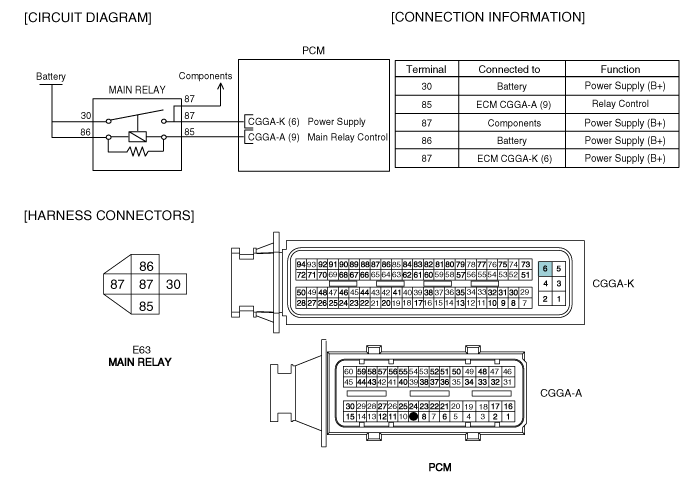
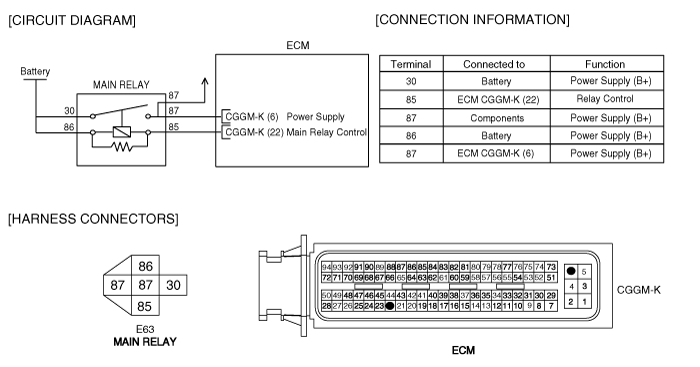
Connect scantool to Data Link Connector(DLC).
IG "ON".
Select "Diagnostic Trouble Codes(DTCs)" mode, and then Press F4(DTAL) to check DTC'sinformation from the DTCs menu
Confirm that "DTC Readiness Flag" indicates "Complete". If not, drive the vehicle within conditionsnoted in the freeze frame data or enable conditions noted in the DTC detecting condition.
Read "DTC Status" parameter.

Is parameter displayed "History(Not Present) fault"?
History fault : DTC occurred but has been cleared.
Present fault : DTC is occurring at present time.

▶ Fault is intermittent caused by poor contact in the sensor's and/or ECM's connector or wasrepaired and ECM memory was not cleared. Thoroughly check connectors for looseness,poor connection, bending, corrosion, contamination, deterioration, or damage.Repair or replace as necessary and then go to "Verification of Vehicle Repair" procedure.

▶ Go to "Terminal & Connector Inspection" procedure.
Many malfunctions in the electrical system are caused by poor harness and terminals. Faults can also be caused by interference from other electrical systems, and mechanical or chemical damage.
Thoroughly check connectors for looseness, poor connection, bending, corrosion, contamination, deterioration, or damage.
Has a problem been found?

▶ Repair as necessary and go to "Verification of vehicle Repair" procedure.

▶ Go to "Main relay circuit inspection" procedure.
Key "OFF".
Disconnect Main relay and Key "ON".
Measure the voltage between terminal 30 of main relay harness connector and chassis ground.
Measure the voltage between terminal 86 of main relay harness connector and chassis ground.
Specification : B+
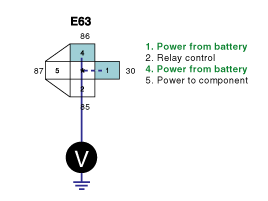
Is the measured voltage within specification?

▶ Go to "System inspection" procedure.

▶ Check the fuse(ECU A 30A) between battery and main relay.
▶ Repair short in power circuit and then go to "Verification of vehicle Repair" procedure.
Alternator circuit check.
Key "OFF".
Disconnect alternator connector.
Key "ON".
Measure the voltage between 1/E50 of alternator harness connector and chassis ground.
Measure the voltage between 1,2/CGG06 of alternator harness connector and chassis ground.
Specification : 12 V
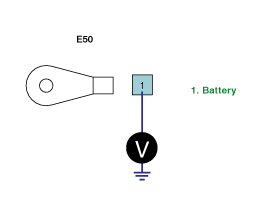
Specification : 10.5~12 V
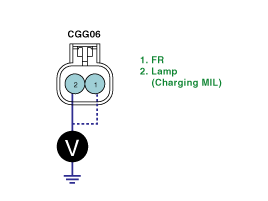
Is the measured voltage within specification?

▶ Go to "Component inspection" procedure.

▶ Repair as necessary and then go to "Verification of vehicle Repair" procedure.
Main relay check.
Key "OFF".
Disconnect Main relay.
Measure the resistance between terminal 30 and 87 of main relay. (Component side)
Measure the resistance between terminal 85 and 86 of main relay. (Component side)
Terminal | Power Approval |
30~87 | NO |
85~86 | YES (Approx. 70Ω ~ 120Ω) |
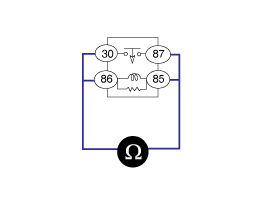
Is the measured resistance within specifications?

▶ Go to "Alternator check" procedure.

▶ Substitute with a known - good Main relay and check for proper operation.
▶ If the problem is corrected, replace Main relay and go to "Verification of Vehicle Repair" procedure.
Alternator check.
Key "OFF".
Check the tension of alternator belt.
Check corrosion, damage or looseness of Battery terminal and Alternator terminal.
Engine start.
Operate electrical parts(Head lamp, Defoger, etc).
Measure the voltage at 2000rpm.
Specification : Approx 12.5V ~ 14.5V
Is the measured voltage within specifications?

▶ Many malfunctions in the electrical system are caused by poor harness(es) and terminals. Faults can also be caused by interference from other electrical systems, and mechanical or chemical damage. So, check poor connections and the related circuit between ECM and component thoroughly. Repair as necessary and go to "Verification of Vehicle Repair" procedure.

▶ Substitute with a known - good Alternator and check for proper operation.
▶ If the problem is corrected, replace Alternator and go to "Verification of Vehicle Repair" procedure.
After a repair, it is essential to verify that the fault has been corrected.
Connect scan tool and select "Diagnostic Trouble Codes(DTCs)" mode.
Press F4(DTAL) and confirm that "DTC Readiness Flag" indicates "Complete".
If not, drive the vehicle within conditions noted in the freeze frame data or enable conditions.
Read "DTC Status" parameter.
Is parameter displayed "History(Not Present) fault"?

▶ System performing to specification at this time. Clear the DTC.

▶ Go to the applicable troubleshooting procedure.